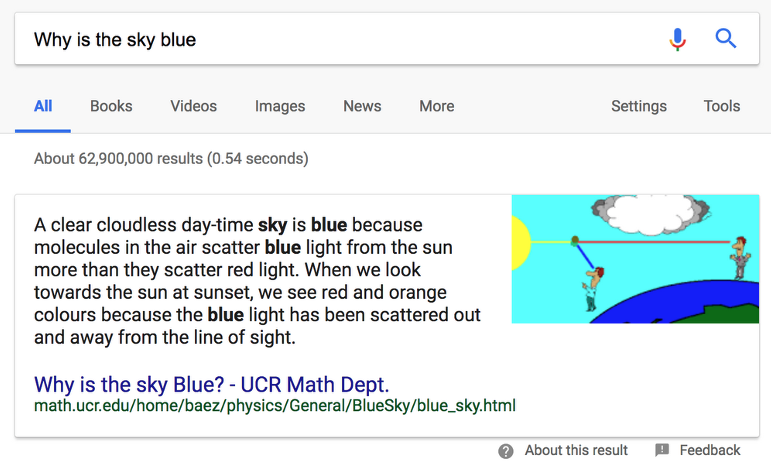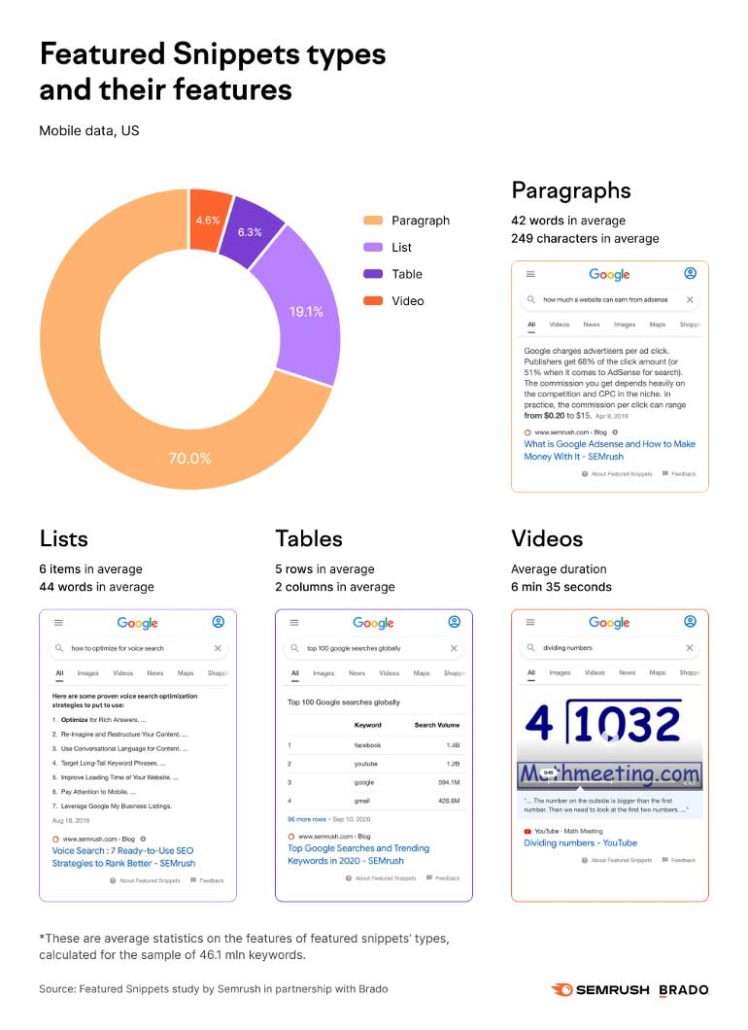Creating content optimized for Google’s featured snippets requires you to follow the basics of on-page SEO with a strategy twist.
You need to do more than standard keyword and searcher intent research. You need to do more than write clear and concise content.
To optimize for featured snippets, you need to research who is ranking for the featured snippet spots you want. To optimize for featured snippets, you need to write content that answers questions and queries.
Optimizing for featured snippets is one of the best SEO and Google search strategies available. Think of how your eyes go to the top of the search engine results page (SERP). And when you add voice search to the mix, optimizing for featured snippets only make sense.
We know that there’s a lot to think and know about when it comes to SEO, Google, search engine rankings, and getting people to read your content. Above all else, we don’t want you to be overwhelmed.
Read this blog, learn about featured snippets and how they can help you. And then contact us with your questions. We get it – there’s a lot to take in. Our goal is to share with you what we know so you can understand why we suggest what we do.
Keep reading to learn the essentials of optimizing for Googles’ featured snippets:
- What the top spot in the search results means for you
- How and why featured snippets matter for SEO
- The 4 types of featured snippets you need to know about
- 6 steps to optimizing your content for featured snippets
What are Google’s Featured Snippets?
Google’s featured snippets are the short snippets of text displayed at the top of the search engine results. Featured snippets immediately answer searcher questions and queries.
These snippets are pulled from your website content and can be paragraphs, lists, or tables.
This example featured snippet directly answers the searcher’s question. The content is clear, concise, and is optimized for the right keywords and searcher intent.

Here is what Google says about featured snippets:
We display featured snippets when our systems determine this format will help people more easily discover what they’re seeking, both from the description about the page and when they click on the link to read the page itself. They’re especially helpful for those on mobile or searching by voice.
Why do Featured Snippets Matter for SEO?
Featured snippets matter for SEO because they are the first search result people see and hear in Google searches.
Featured snippets are used to answer voice search questions. For mobile searches, the featured snippet uses 50% or more of the screen.
To put it simply – featured snippets are the first thing people see, hear, read, and typically click.
Think of how often you scroll past the first search result that answers your questions – likely not often. This is what we want for your content – to rank in the featured snippet spot so you can get more eyes and clicks on your content.
Ranking for featured snippets is one of the best and easiest ways to improve your organic search results. Content optimized for featured snippets naturally meets Google’s standards for quality and a positive user experience.
Recent research from Engine Scout reveals that featured snippets account for a 35.1% share of all clicks.
As an extra bonus, featured snippets give your brand visibility. Searchers see, hear, and read your content first. This helps solidify your brand as a trusted expert and market leader.
The 4 Types of Featured Snippets
The 4 types of featured snippets you can optimize for are:
- Paragraph featured snippet
- List featured snippet
- Table featured snippet
- Video featured snippet
This featured snippet study data from Semrush gives you the quick facts on featured snippet types and options:

1. Paragraph Featured Snippet
Paragraph featured snippets typically answer questions and queries that start with “what” or “why”. On average, paragraph featured snippets contain 42 words and 249 characters.
Paragraph featured snippets are informational, directly answering searcher questions and queries.
2. List Featured Snippet
There are two types of list featured snippets: numbered lists and bulleted lists. List featured snippets answer “why” and “how” questions.
Numbered list featured snippets are sequential and typically include steps or “how to” information. Use numbered lists to answer questions such as “how many” or “how do I”.
Bulleted list featured snippets typically include lists that don’t need to be in sequential order. These featured snippets are ideal when listing three or more items.
The best list featured snippets include short and clear bullets or numbers. Focus on including exactly what the reader needs to know.
On average list featured snippets include 6 items and 44 words.
3. Table Featured Snippet
Table featured snippets are ideal for displaying data, features, prices, and comparison information.
Google may pull a table from your content and use this as the featured snippet, or it may create a table based on your content. To optimize for table featured snippets, it’s best to create tables using HTML table tags.
On average table featured snippets include 5 rows, 2 columns, and 40 – 45 words.
4. Video Featured Snippet
Only 4.6% of featured snippets are videos. Typically, these videos are pulled from YouTube.
The average length of a video featured snippet is 6 minutes and 35 seconds. Google may choose to display your entire video or jump the reader directly to the right place in the video.
Optimize for video featured snippets only when your audience prefers video content. Focus on clear and concise videos that directly answer searcher questions.
Make sure you know what your audience is looking for and how they like to consume content.
How to Optimize Content for Featured Snippets
To optimize for featured snippets, you need to follow the basics of on-page SEO with extra emphasis on strategy.
Featured snippet strategy boils down to knowing what featured snippets your competitors are ranking for and creating content that outranks your competitors.
Follow these 6 steps to optimize for featured snippets:
1. Competitor Research
Use a tool like Semrush to learn the featured snippets your competitor is ranking for.
Review these featured snippets, drill down into the keywords and keyword phrases, and understand the search intent behind these featured snippets. Then write content that does a better job than your competitor at answering the question or query.
2. Keyword Research
You need to go beyond single or double-word keyword phrases. Research from Semrush and other sources tells us the more keywords in the search query that you can match for – the better.
- Of keywords made up of 10 words, 55.5% had a featured snippet.
To rank for these 10 keywords, focus on the questions/queries people are asking, and the search intent behind the questions.
For example, the search query “what do I need to know about SEO strategy?”, could be answered with a bulleted list that includes the top 10 things people need to know about SEO strategy.
3. Think in Questions
Typically, people use Google to ask questions and get answers. You need to know what questions your audience is asking and the information they’re looking for.
When search questions/queries include a question triggering word, a featured snippet is typically returned. The most common words that trigger a feature snippet include:
- Why: 77.63% of featured snippet answers
- Can: 72.40% of featured snippet answers
- Do: 67.54% of featured snippet answers
- Are: 67.51% of featured snippet answers
- How: 65.27% of featured snippet answers
4. Create a Featured Snippet Content Plan
To create your featured snippet content plan remember what you learned about your competitors, search intent, and keywords.
Determine the best format to answer the search question/query and start writing. Focus on using your keywords naturally and providing a clear and concise answer. Remember the average length of featured snippets and your featured snippet type options.
If you’re struggling to answer a question concisely in a paragraph, it’s likely you should be using a list or table featured snippet.
Answer the question directly while ensuring you provide more information than in your competitor’s featured snippet.
5. Optimize On-Page SEO for Featured Snippets
The basics of on-page SEO still apply for featured snippets. Make sure your content is:
- Clear and concise.
- Formatted with H1, H2, H3, H4 tags.
- Uses lists to clearly communicate information.
- HTML table tags are applied correctly.
- Include question keywords in your title, URL, and headlines. For example: How to Optimize for Google Featured Snippets.
- Use internal links to help readers find more information.
- Be mobile-friendly. Remember 50% or more of the mobile screen is used by a featured snippet. Make sure your content is easily readable and accessible on mobile devices.
- Focus on the Page Experience. Google wants to give people content that is easy to read, loads quickly, and is secure.
6. Refresh Existing Content
It’s very likely you have content that needs to be refreshed or updated. This is the perfect opportunity to focus on optimizing for featured snippets.
Review your existing content and look for content that matches your keyword strategy. Next rewrite and reformat this content to outrank your competitors. Pay attention to the featured snippet type your competitor is ranking for and write better content to earn this spot.
Extra Reading about Content, Google, SEO, and Search
These blogs and checklists can help you optimize your content to give your audience and search engines exactly what they want:
- Website and Content Quality Checklists: Four Content Self-Assessment Checklists
- Your Complete Guide to SEO
- SEO and Google Checklists to Help Your Rank in 2021
- Searcher Intent and SEO: Why Searcher Intent Should Be Part of Your SEO Strategy
We know we’ve given you a lot to think about and do in this blog post. Remember, you’re not alone – we’re here to help you.
Contact us with your questions about optimizing for featured snippets, SEO, search, and Google.
About the author Jane Phelps is the CEO/Partner at Know Agency. Jane leads client SEO strategy and handles all aspects of in-house SEO demands. This includes providing SEO training, competitive analysis, keyword research, algorithm analysis, and the review of all new content to ensure SEO best-practices are followed. Jane holds a Master’s Certificate in Online Marketing from the University of San Francisco, is BrightEdge Certified.



